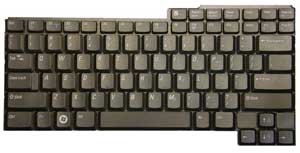Laptop keys blog
Why is there more than one type of retainer clip for the same laptop model?
Believe it or not, this is a question we get asked all the time. To purchase a laptop key repair kit, you need to tell us your make, model, then choose the style of retainer clip you have. This is not something that we do just to annoy our customers, it is a very important step as often times, a laptop manufacturer will have several variations of one keyboard of the same model. What do we mean by this? Although the outside of the keyboard looks the same, the differences in the plastic parts that connect the laptop key cap to the keyboard base can be vastly different. Take for example the Dell Inspiron E1505, one of our more popular models. The keyboard looks like this:

All keyboards for the Dell Inspiron E1505 look exactly like this and they are all interchangeable. The problem is when you remove a key, you can find many different things. You will find different retainer clip styles, the exact number of clip styles depend on the make and model but there are typically 2-4 variations for any given keyboard. Now, these retainer clips are what connect the key cap to the keyboard and are responsible for the "scissor" action that allows the up/down travel of the laptop key. The retainer clip is also known as a "hinge" because of this behavior. Let's remove the letter "T". Here are four possible retainer clips you will find underneath the key (labeled A, B, C and D):

So now the question is "Why are there different retainer clip types? How come they can't all be the same?". Well, that is a good question and it has a very simple answer: patents. What we mean is when you buy a laptop computer, the keyboard it comes with is not manufactured by the laptop manufacturer. For instance, the keyboards you find on the Dell Inspiron E1505 are not produced by Dell, in fact, they come from four different manufacturers who all have their own patent on the retainer clip. That means that the company who makes keyboard "A" cannot use the same retainer clip style as company "B", so they have to make up their own spin on the retainer clip style.
Using four different companies to purchase keyboards from is good for Dell because it keeps them in competition with each other (keeping prices low) as well as ensuring a steady supply of keyboards. If one company stops producing them, they have three other suppliers supplying the same product.
Furthermore, a key cap from clip type "A" will not fit on a keyboard with clip type "B" or "C" or "D". The keys are not interchangeable between laptops because the small plastic hooks on the under side of the laptop key are positioned perfectly for its matching retainer clip. Similarily, the retainer clips are not interchangeable between keyboards because the metal hooks on the keyboard base are positioned exactly for that particular retainer clip as well.
To observe the configuration of the retainer clip hinge type, the laptop key needs to be removed. During the purchasing process, it is often necessary for the retainer clip type to be identified. In the case that the key cap is not removed already (suppose the laptop key is simply worn out or damaged and needs to be replaced), below are tips and tricks to safely remove the laptop key cap for hinge identification.
The easiest and most common method for removal is to place the index finder in the corner of the key cap and gently pull up. If the key does not separate from the retainer clip, try the same on an diagonal corner. When the key separates, there is a distinct "snap" sound as the plastic hooks on the underside separate. Once you are able to lift up on one corner, do the same to an adjacent corner. At this point the laptop key can be lifted up and removed from the keyboard base.
The key cap will always have a little play in it so if this method does not work, a small screwdriver can be used to gently lift up the key enough so you can observe the way the retainer clip attaches to the back of the key. This information can be used to determine the best way to remove the key cap.
For larger keys, there my be an extra metal bar that hooks into the base of the laptop keyboard. The metal bar will always slide into two metal brackets on the keyboard base so make sure that they slide out properly when removing the laptop keyboard key from the base. Below is a video of some samples we put together for removing various keys.